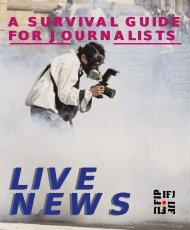Removing Barriers, Increasing Effectiveness - amarc
Removing Barriers, Increasing Effectiveness - amarc
Removing Barriers, Increasing Effectiveness - amarc
Create successful ePaper yourself
Turn your PDF publications into a flip-book with our unique Google optimized e-Paper software.
Radio Douentza was one of the first independent community radios in Mali, operating ona very small budget, but creating impressive achievements and impact on the localcommunities. Those exposed to the radio were much better informed about AIDS thanother regions, 70% of those claimed radio as their main source of information. Afterbroadcasts which recommended marking and conserving naturally occurring trees, itwas found that the number of farmers doing this increased from 6% to 43% in thesample.29. Faye, Martin & Kessler, Roy (2006). INFORMO(T)RAC Programme – JointReview Mission Report: A Review of the INFORMO(T)RAC (Initiative for MobilTraining of community Radio) Programme. [Electronic Version] Website:http://www.informotrac.org/downloads/informotrac_mission_report.pdfThe mission fully supports RNTC’s belief that Community Radio Stations (CRS) couldplay an important role in a structural approach to fight poverty from the bottom up bystimulating active participation in social processes. As the mission saw, CRS docontribute to Civil Society Development (CSD), and as such, the INFORMO(T)RACprogramme (IP) certainly (indirectly) contributes to poverty alleviation, especially insocieties where previous war situations have destroyed various bases of the society.30. Jackson, Edward T. & Kassam, Yusuf (1998). Participatory Evaluation inDevelopment Cooperation. IDRC. Website: http://www.idrc.ca/openebooks/868-6/This book provides readers with a variety of articles covering such critical themes asethics, techniques, case studies, historic reflections, and invitations to action. Further,this anthology brings together some of the best-known specialists from many parts of theworld.Who has the right to evaluate whom? If evaluation is, as Kamla Bhasin notes in thiscollection, "reflection on action," why is the literature of evaluation so monopolized by thewritings of those who serve the dominant interests? Why does the evaluation literatureso seldom reflect the direct concerns of the majority of the poor? Chapter 4 is on“Participatory Impact Assessment as a Tool for Change”. The second part of the book isa collection of case studies.31. Geerts, Andrés, Van Oeyen, Victor, & Villamayor, Claudia. (2004). La PrácticaInspira – La Radio Popular y Comunitaria frente al Nuevo Siglo. ALER-AMARC.The most comprehensive report on sustainability of community radio in Latin America,covering 32 radio stations from the perspective of social, institutional and financialsustainability. The book (406 pages), includes chapters on the methodology that wasused for the studies, which involved a group of 24 researchers.The methodology included fieldwork at the community level, extensive interviews in eachradio station with journalists and staff, with members of the audience, as well aspersonal observation, analysis of programming, and review of documentation andarchives.32. Ana Lucía Gonzalez Paz, La Radio comunitaria: El Camino hacia unaDemocracia Participativa. (Unpublished).This research focuses on community radio in Colombia. It includes several case studiesand chapters on legislation, conceptual framework of community radio, participation andevaluation.Although not specifically on impact, this report includes important contribution towardsanalyzing and conceptualizing community radio. The two case studies are built oninterviews, field work and observation.AMARC Community Radio Social Impact Assessment 2007 Page 111 of 128
















